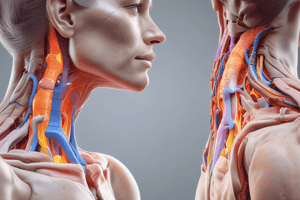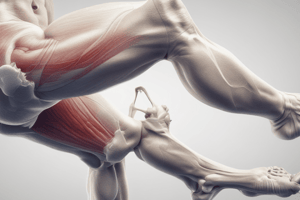Podcast
Questions and Answers
Which of the following best describes the primary difference between a sprain and a strain?
Which of the following best describes the primary difference between a sprain and a strain?
- A sprain is an acute injury, while a strain is a chronic injury.
- A sprain involves injury to a muscle, while a strain involves injury to a ligament.
- A sprain always requires surgical intervention, while a strain can be managed conservatively.
- A sprain involves injury to a ligament, while a strain involves injury to a muscle. (correct)
A patient presents with ankle pain, swelling, and difficulty bearing weight after twisting their ankle. During the assessment, which finding would be MOST indicative of a sprain rather than a fracture?
A patient presents with ankle pain, swelling, and difficulty bearing weight after twisting their ankle. During the assessment, which finding would be MOST indicative of a sprain rather than a fracture?
- Diffuse swelling and ecchymosis around the ankle joint. (correct)
- Obvious bony deformity visible upon inspection.
- Significant point tenderness upon palpation of the fibula.
- Presence of a 'pop' sound at the time of injury.
What is the PRIMARY goal of the acute phase management of a sprain?
What is the PRIMARY goal of the acute phase management of a sprain?
- Begin strengthening exercises to prevent future injury.
- Apply heat to the affected area to increase blood flow and promote healing.
- Restore full range of motion immediately through aggressive physical therapy.
- Control pain, minimize swelling, and maintain/regain range of motion. (correct)
A patient is diagnosed with a Grade 2 ankle sprain. Based on this classification, which of the following characteristics is MOST likely to be present?
A patient is diagnosed with a Grade 2 ankle sprain. Based on this classification, which of the following characteristics is MOST likely to be present?
During the RICE protocol for an ankle sprain, when is it generally appropriate to transition from ice to heat application?
During the RICE protocol for an ankle sprain, when is it generally appropriate to transition from ice to heat application?
A patient with a suspected ankle sprain has been following the RICE protocol for 3 weeks with minimal improvement. What is the MOST appropriate next step in management?
A patient with a suspected ankle sprain has been following the RICE protocol for 3 weeks with minimal improvement. What is the MOST appropriate next step in management?
Which of the following activities is MOST important to include in patient education to prevent future sprains after recovering from an ankle sprain?
Which of the following activities is MOST important to include in patient education to prevent future sprains after recovering from an ankle sprain?
Which of the following assessment findings would be MOST indicative of a Grade 3 sprain?
Which of the following assessment findings would be MOST indicative of a Grade 3 sprain?
To effectively minimize swelling in the acute phase of sprain management besides RICE protocol, what other measure is MOST appropriate?
To effectively minimize swelling in the acute phase of sprain management besides RICE protocol, what other measure is MOST appropriate?
A patient reports hearing a 'pop' at the time of their ankle injury. While this can occur in various injuries, which of the following is the MOST likely implication of this symptom in the context of a sprain?
A patient reports hearing a 'pop' at the time of their ankle injury. While this can occur in various injuries, which of the following is the MOST likely implication of this symptom in the context of a sprain?
What is the PRIMARY reason for using NSAIDs in the acute management of a sprain?
What is the PRIMARY reason for using NSAIDs in the acute management of a sprain?
A patient is being discharged after being treated for a Grade 2 ankle sprain. What is the MOST important instruction to give regarding weight-bearing?
A patient is being discharged after being treated for a Grade 2 ankle sprain. What is the MOST important instruction to give regarding weight-bearing?
When is referral to an orthopedist MOST appropriate for a patient with a sprain?
When is referral to an orthopedist MOST appropriate for a patient with a sprain?
Which of the following factors differentiates a grade 1 sprain from a grade 2 sprain?
Which of the following factors differentiates a grade 1 sprain from a grade 2 sprain?
Flashcards
What is a sprain?
What is a sprain?
Stretching or partial tear of ligaments.
What is a strain?
What is a strain?
Injury to a muscle or tendon.
Sprain/Strain Assessment findings?
Sprain/Strain Assessment findings?
Pain, swelling, erythema (redness), ecchymosis (bruising).
Grade 1 sprain?
Grade 1 sprain?
Signup and view all the flashcards
Grade 2 sprain?
Grade 2 sprain?
Signup and view all the flashcards
Grade 3 sprain?
Grade 3 sprain?
Signup and view all the flashcards
RICE for sprains/strains?
RICE for sprains/strains?
Signup and view all the flashcards
Sprains: Key Info
Sprains: Key Info
Signup and view all the flashcards
Sprain Symptoms
Sprain Symptoms
Signup and view all the flashcards
Sprain: Differential Dx
Sprain: Differential Dx
Signup and view all the flashcards
Sprain Diagnostics
Sprain Diagnostics
Signup and view all the flashcards
Acute Sprain Goal
Acute Sprain Goal
Signup and view all the flashcards
Sprain Management
Sprain Management
Signup and view all the flashcards
Sprain Timeline
Sprain Timeline
Signup and view all the flashcards




